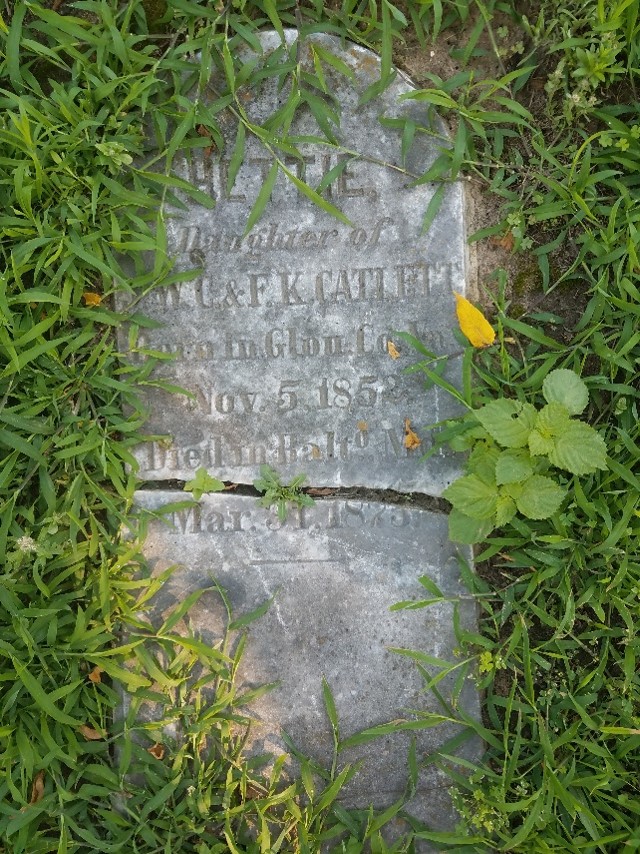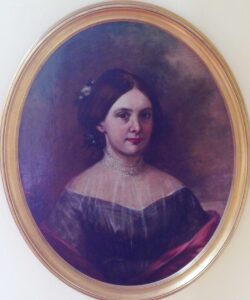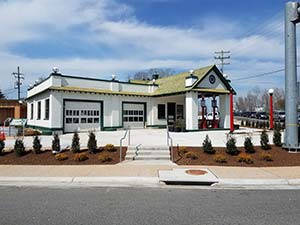Written by Sara Lewis, Development Officer
Born in the fall of 1852, Hettie Catlett was the ninth child of 49-year-old John W. C. Catlett of Timberneck (1803-1883) and the fourth child of Frances “Fanny” Burwell Catlett (1814-1903), his second wife. Hettie’s birth was not celebrated in any known letters or journals, perhaps since, in the mid-19th century, 40 percent of children were not expected to reach their fifth birthday, especially those born in rural areas like Gloucester. Indeed, John Catlett had already lost two children as toddlers, among the five children borne by his first wife, Agnes Thruston (1806-1838).

A photo taken of the cemetery 50 years later, on March 31, 1925, shows the tombstone standing. Today, Hettie’s tombstone, like most of the others, has toppled for unknown reasons. One possibility is invasion of the area by strong and shallow roots spread by nearby weeping willow trees. The tree with its drooping branches is a frequent form of iconography used in the late 19th century in relation to death.
Hettie’s father did not mention her birth in his daily farm journal,[i] which includes records of all farming activities on the property and household expenses. The farm, his career as an attorney, his political interests, and now a second brood of children were among his abundant management responsibilities. Throughout 1852 and in subsequent years, Catlett’s ledger records more than a few purchases of bitters of wild cherry and cherry pectoral, patent medicines made from alcohol, opiates, and cherry flavoring, offered to those suffering from pulmonary diseases, such as “consumption” (tuberculosis) and whooping cough. Apparently, doctors prescribed the medicine for members of the household and perhaps for his enslaved people who tended to the family and farm. In the decade before the Civil War, Catlett took care of the enslaved as they were his most valuable “liquid asset“.[ii]
Thirty-eight years old when Hettie was born, Fanny was arguably not as busy as her husband. While she had 3 other young children, Charles (7), William (5), and Mary (2), she also had plenty of help: the 1850 US Census lists the family’s white servant, Lucy Flowers, and the Census Slave Schedule indicates the Catletts enslaved 43 people. Before Hettie’s birth, Fanny’s charges also included two children by John W.C. Catlett’s first marriage. After Hettie’s birth, Fanny would bear two more children.
With the approach of the Civil War, turmoil filled the home where Hettie lived as a young child. The U.S. Army launched the Peninsula Campaign just across the York River from the Catlett home between March and July of 1862. The Catletts certainly heard rumblings.[iii] The first pitched battle, the Battle of Williamsburg, was within sight of young Hettie and her siblings. Stepbrother John and brothers Charles and William left home to join the Confederate forces. Enslaved people ran to freedom in Union camps at Gloucester Point and Yorktown. Union forces raided Gloucester farms for food to feed their troops and to stop the flow of goods to the Confederate Army. Soon after the end of the war and his return home, brother William died. The Catletts had to adapt to life without “free” labor and additional income earned by slaves or brought to the household by their sale.[iv] Between the Censuses of 1860 and 1870, the family’s real estate value decreased from $24,000 to $10,500 and their personal property from $39,400 (mainly the value of the people Catlett enslaved) to $1,511. But the Catletts recovered. The 1870 Census included Sally Nelson (15) and Lucy Jones (18) in the household, Black domestic servants about Hattie’s age.
In the collection of letters held in the College of William & Mary’s Swem Library Special Collections, cited in previous blogposts about Lives from the Catlett Family Cemetery, there is only one letter from Hettie to her mother. It reveals the loving attachment between mother and child. “My own dear Mama; Everybody has gone out . . . so I gladly take advantage of the quiet to write to you.” On March 16, 1870, when she wrote, Hettie was 18 years old. She was staying with her aunt, Fanny’s older sister, Anne Powell Burwell Garland, and first cousins Mag (short for Margaret) and Nannie (a pet name for Anne) Garland.[v]
Hettie was staying with them, close to Richmond, for a dental operation. Her letter indicates the stay was enjoyable, although possibly overwhelming to the young rural woman whose confidence was weakened by her appearance.
“All [of the Garlands] are just as charming and kind to me as it is possible for any people to be. Cousin Nan is lovely, beautiful and sweet, but I’m too poor a pensman to think of attempting to describe to you this charming and accomplished household, you know I feel like a sort of nonentity any way, and when I first got here I felt unhappy because I was not smart and accomplished like the others, so of course I looked uglier than ever for you know unless I smile, I’m not ‘pretty’ . . . Cousin Mag is full of sparkling wit and very pretty . . . I will wait until I get home to tell you about my going to the theatres and a concert . . . ”

Hettie relayed a message from Aunt Ann. She asked Fanny to send a box of chickens, eggs, vegetables, and oysters. “Have some of the chickens killed . . . You never saw people enjoy anything as much as they did the other box, nearly went crazy over the oysters . . .”
The young lady was also worried about her father’s health. “How is pa? I have been quite anxious about him . . .” He was 67 but would outlive her. Hettie died five years after her letter was written, on March 31, 1875, in Baltimore, Maryland. The records available to date are silent as to the circumstances. Hettie was the fourth of John W. C. Catlett’s eleven children to die and she was the second death among Fanny’s six.
Two years after Hettie’s death, her sister Mary Armistead Burwell Jones named her first girl Hettie probably in memory of her sister and an aunt of the same name.
[i] One of John W. C. Catlett’s daily farm journals was recently donated to the Fairfield Foundation by his great-granddaughter, Ann Burruss, whose parents collected them from the Catlett office in the 1980s. This ledger and other saved records will be key to future historical interpretation.
[ii] A well-established market for slaves meant they were considered highly ‘liquid’ assets that could easily be converted to cash if the owners wished to sell a slave for any reason. From Roger L. Ransom, Conflict and Compromise: The Political Economy of Slavery, Emancipation, and the American Civil War. New York and Cambridge, U.K.: Cambridge University Press, 1989, p. 46.
[iii] To follow battle-related events, John W.C. Catlett visited the fortifications at Gloucester Point, where some of the people he owned were engaged as laborers constructing the fortifications.
[iv] Some of the people he formerly enslaved continued to live nearby. They worked for wages and brought food and other items to Timberneck to sell.
[v] Anne Garland’s husband died earlier, in 1854 when most of the family lived in St. Louis, Missouri. Although her older children continued to live there, Anne brought her youngest daughters “home” to Virginia.



This is very interesting and I enjoyed learning.
I was curious about Hetties stay in Richmond for a dental operation. Do you you know any details?
Unfortunately, no. All we have is what is in the letter. I know this was a time of change in the dental profession. I did not take the time to do more research, but I’m sure it would be interesting to know who she saw and for what exactly. Sara
Sara
I loved reading about Hetty, she really comes to life through your article. Thanks for your research about her. Very interesting. She made it to Baltimore.
Very interesting……enjoyed the read. I did not know that Ann Burruss was a great granddaughter—-she was a colleague (Peasley Middle School) and personal friend of mine. Wish she were still here so I could ask some questions.
That’s the other Ann Burruss, deceased. She is a distant cousin of mine on my father’s side. I’m the Ann who donated the journal and very much alive. My mother was Mary Armistead Catlett Burruss.
Thanks, Mary!
I would argue that Fannie Catlett was as busy as her husband, just in a different way. In reading the diaries (admittedly few) of gentry women, their days are full of child-rearing and bearing, supervising slaves, running their households, entertaining family and friends, etc. Barbara Carson’s researches certainly revealed this reality as have other historians researching women’s lives from the past.
Sara, many thanks for another well-researched and well-written interesting history!
Thank you, Jennie!
An excellent read. You certainly brought Hettie to life with your words and related historical events. Tell us more!!
Thank you Sara for another interesting historical biography!
Thanks, Anne
Sara,
I love Gloucester history. Thank you for the research.
Thanks Sara, another very interesting article. Hettie was certainly not a “poor pensman,” as she describes herself.
Hettie has a death cert in B’more. If the MD Archives ever puts them on line here is the look up info.
Hettie Catlett 1875/03/31 01979 CR 48,045.